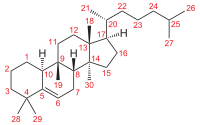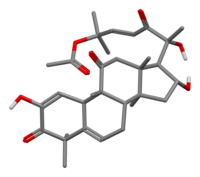

Cucurbitacins are a class of biochemical compounds that some plants – notably members of the pumpkin and gourd family, Cucurbitaceae – produce and which function as a defense against herbivores. Cucurbitacins and their derivatives have also been found in many other plant families (including Brassicaceae, Scrophulariaceae, Begoniaceae, Elaeocarpaceae, Datiscaceae, Desfontainiaceae, Polemoniaceae, Primulaceae, Rubiaceae, Sterculiaceae, Rosaceae, and Thymelaeaceae), in some mushrooms (including Russula and Hebeloma) and even in some marine mollusks.
Cucurbitacins may be a taste deterrent in plants foraged by some animals and in some edible plants preferred by humans, such as cucumbers and zucchinis.[1] In laboratory research, cucurbitacins have cytotoxic properties and are under study for their potential biological activity.[2][3]
Cucurbitacins are chemically classified as triterpenes, formally derived from cucurbitane, a triterpene hydrocarbon – specifically, from the unsaturated variant cucurbit-5-ene, or 19(10→9β)-abeo-10α-lanost-5-ene. They often occur as glycosides.[4] Most cucurbitacins are tetracyclic except some have an extra ring due to formal cyclization between C16 and C24 as in cucurbitacin S and cucurbitacin T.[5][6]
- ^ Zeitung S (21 August 2015). "Gift in Zucchini und Kürbis". Süddeutsche.de (in German). Retrieved 2020-08-21.
- ^ Alghasham AA (January 2013). "Cucurbitacins - a promising target for cancer therapy". International Journal of Health Sciences. 7 (1): 77–89. doi:10.12816/0006025. PMC 3612419. PMID 23559908.
- ^ Kapoor S (May 2013). "Cucurbitacin B and its rapidly emerging role in the management of systemic malignancies besides lung carcinomas". Cancer Biotherapy & Radiopharmaceuticals. 28 (4): 359. doi:10.1089/cbr.2012.1373. PMID 23350897.
- ^ Chen JC, Chiu MH, Nie RL, Cordell GA, Qiu SX (June 2005). "Cucurbitacins and cucurbitane glycosides: structures and biological activities". Natural Product Reports. 22 (3): 386–99. doi:10.1039/b418841c. PMID 16010347.
- ^ Gamlath CB, Gunatilaka AA, Alvi KA, Atta-ur-Rahman, Balasubramaniam S (1988-01-01). "Cucurbitacins of Colocynthis vulgaris". Phytochemistry. 27 (10): 3225–3229. Bibcode:1988PChem..27.3225G. doi:10.1016/0031-9422(88)80031-1. ISSN 0031-9422.
- ^ Kaushik U, Aeri V, Mir SR (2015-05-05). "Cucurbitacins – An insight into medicinal leads from nature". Pharmacognosy Reviews. 9 (17): 12–18. doi:10.4103/0973-7847.156314. PMC 4441156. PMID 26009687.